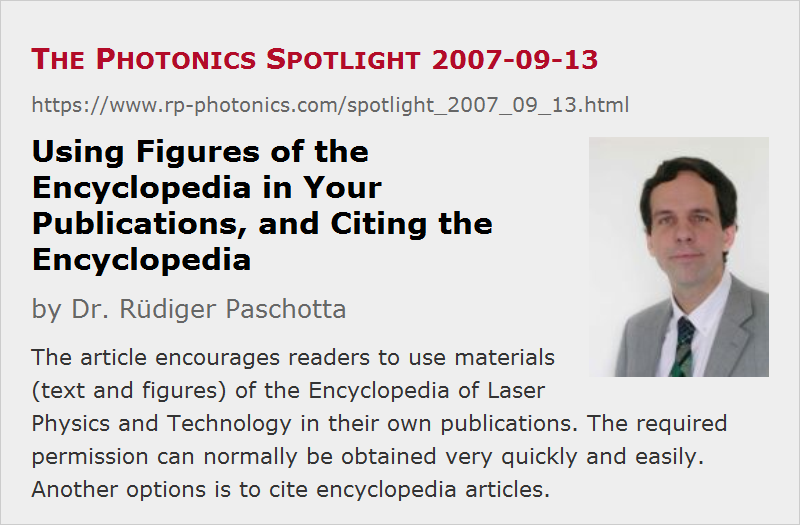Using Figures of the Encyclopedia in Your Publications, and Citing the Encyclopedia
Posted on 2007-09-13 as a part of the Photonics Spotlight (available as e-mail newsletter!)
Permanent link: https://www.rp-photonics.com/spotlight_2007_09_13.html
Author: Dr. Rüdiger Paschotta, RP Photonics Consulting GmbH
Abstract: The article encourages readers to use materials (text and figures) of the Encyclopedia of Laser Physics and Technology in their own publications. The required permission can normally be obtained very quickly and easily. Another options is to cite encyclopedia articles.

The Encyclopedia of Laser Physics and Technology contains more than 250 figures, and various readers have successfully asked for the permission to use such figures in their own publications, such as textbooks, journals, scientific articles or conference presentations, and websites. Asking RP Photonics is exactly the right thing to do. Usually, you can get the permission to use such figures (or text) if you are willing to properly acknowledge the origin of the materials. In some cases (particularly concerning book projects), you may even obtain figures with higher resolution than shown in the online encyclopedia, or figures with a somewhat modified content (e.g. with different parameters for some curves). Just contact RP Photonics, and you are likely to have a convenient and fair solution very soon.
Instead of copying materials, you can also cite the encyclopedia e.g. in scientific publications. Some people hesitate to cite online content, but note the following:
- The URLs of all encyclopedia articles are considered to be permanent. In the unlikely case e.g. that a filename would have to be changed, a proper automatic redirection would be installed in order to prevent that users are left with an error page.
- Online content can change, of course. In particular, the online encyclopedia articles are often expanded or otherwise improved. However, it is unlikely that this would invalidate a citation.
- One of the important criteria for citations is the availability for the readers. Nowadays, it is by far more convenient for most readers to type a URL into their browser's address line, than searching for a book or journal article in the next scientific library.
- Even in scientific publications, the citation of an encyclopedia article is often more appropriate than that of some other specialized articles. As an example, someone recently cited the article on brightness of a laser. It would be quite hard to find a scientific article clarifying such an issue, and the same situation would occur e.g. when searching for a text explaining different specifications for doping concentrations of laser crystals, or the basics of four-level and three-level gain media, or what exactly is relative intensity noise of lasers.
Those who still hesitate might wait until a print version of the Encyclopedia of Laser Physics and Technology is published.
This article is a posting of the Photonics Spotlight, authored by Dr. Rüdiger Paschotta. You may link to this page and cite it, because its location is permanent. See also the RP Photonics Encyclopedia.
Note that you can also receive the articles in the form of a newsletter or with an RSS feed.
Questions and Comments from Users
Here you can submit questions and comments. As far as they get accepted by the author, they will appear above this paragraph together with the author’s answer. The author will decide on acceptance based on certain criteria. Essentially, the issue must be of sufficiently broad interest.
Please do not enter personal data here; we would otherwise delete it soon. (See also our privacy declaration.) If you wish to receive personal feedback or consultancy from the author, please contact him e.g. via e-mail.
By submitting the information, you give your consent to the potential publication of your inputs on our website according to our rules. (If you later retract your consent, we will delete those inputs.) As your inputs are first reviewed by the author, they may be published with some delay.
 |





If you like this page, please share the link with your friends and colleagues, e.g. via social media:
These sharing buttons are implemented in a privacy-friendly way!